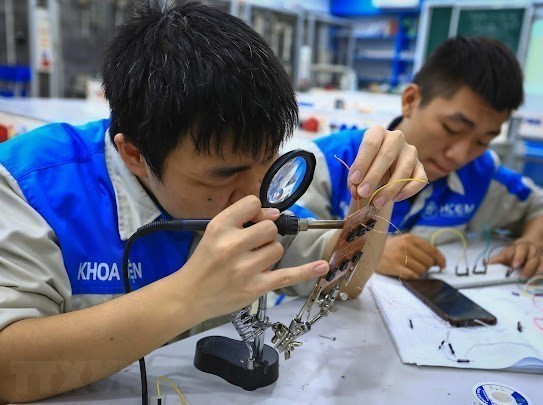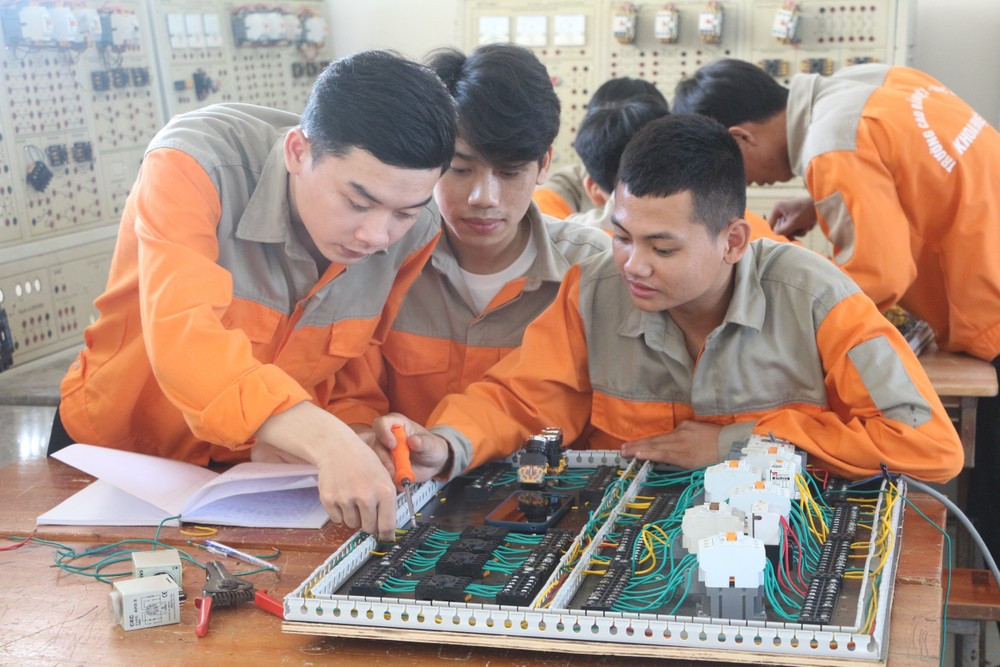Regarding the challenges facing the young workforce, many experts point out that low skills are the “barrier” for young Vietnamese workers in the job market.

Young workforce plays an important role in the socio-economic development of the country.
Vietnam is in the "golden population structure" phase. This phase is expected to last until about 2038.
Taking advantage of opportunities, promoting the advantages of young human resources, and enhancing vocational skills to adapt to the labor market is very necessary, contributing to improving labor productivity and developing the country.
Experts affirm that in any country, young people are always an important population force that constitutes the main labor force of the economy, and a social group that plays an important role in the country's development.
Data from the General Statistics Office shows that Vietnam is currently in the period of golden population structure and also in the process of population aging. In general, in 2023, the labor force aged 15 and over will be 52.4 million people. The number of unemployed young people (aged 15-24) in 2023 will be about 437,300 people, accounting for over 41% of the total number of unemployed people.
Also in 2023, the trained workforce with degrees and certificates in our country will account for 27% of the country's workforce. This figure shows a significant challenge in improving the technical expertise of workers, including the young workforce.
Regarding the challenges facing the young workforce, many opinions also point out that low skills are the "barrier" for young Vietnamese workers in the job market.
Therefore, improving the skills of young workers and creating conditions for young workers to participate in the global human resource supply chain is an urgent requirement.
According to the International Labor Organization (ILO), every 5 years, 30% of current occupational skills of workers will no longer be used and must be replaced by new skills.
This requires young workers in businesses to be equipped not only with professional skills but also with skills to adapt to change.
The International Labor Organization believes that in the context of the 4th industrial revolution, many traditional occupations will disappear but many new occupations and jobs will appear, creating job opportunities for young workers.
In this context, young people, in addition to needing to be equipped with vocational skills through vocational training to have satisfactory jobs, need to be equipped with soft skills and adaptive skills to be able to work in the 4.0 environment, and have the ability to cope with circumstances, especially with non-traditional risks.
Young workers are quick to learn science and technology, are highly dynamic, and account for the majority of the workforce through vocational training. These are advantages for young workers to actively practice and equip themselves with skills to meet the labor market.
Dr. Truong Minh Huy Vu, Deputy Director of the Ho Chi Minh City Institute for Development Studies, affirmed that in Vietnam there is still a gap between the skills of workers and the skills needed by the labor market, leading to a low rate of employment of trained workers, while the market lacks qualified workers with vocational skills.
Many international organizations have stated that vocational skills will be the “new international currency” in the future labor market, because they bring better competitiveness and higher labor productivity.
In the current context, a skilled workforce is decisive for the productivity of both workers and businesses.
For young workers, vocational skills are even more important, helping them stand firm in the current and future labor market and contribute effectively to the economy.
According to experts, the 4th industrial revolution and the process of economic restructuring require improving the quality of human resources, in which young people are the main force playing an important role, which is the top concern of countries, managers and businesses. At the same time, the desire to have professional qualifications and skills to have stable jobs and high income is the legitimate desire and need of young people.

A representative of the Ministry of Labor, War Invalids and Social Affairs said that low skills are the “barrier” for Vietnamese youth workers in the 4.0 job market. Improving the skills of young workers and creating conditions for Vietnamese youth workers to participate in the global human resource supply chain is an urgent requirement of the economy and this is a big challenge, requiring drastic changes in Vietnam's vocational education system.
In addition, strengthening labor market forecasting, organizing training, especially training in new industries, "anticipating" labor market needs are implemented by all levels and sectors, contributing to supplying human resources, especially young human resources for the labor market.
From a local perspective, Mr. Dang Minh Thong, Vice Chairman of the People's Committee of Ba Ria-Vung Tau province, informed that as a locality in the Southern key economic zone with a large demand for labor, the province is very interested in promoting vocational training and improving skills for the workforce, especially young workers. Sectors and organizations strengthen propaganda for young people about the role of vocational education and the importance of labor skills, while functional agencies work closely together to support learners in finding suitable jobs after graduating from training institutions.
The province aims to have 30% of local workers with certificates and diplomas by 2025, 80% of workers with information technology skills, and 40%-50% of junior high school and high school graduates enter the vocational education system, supplementing a direct, young, and dynamic workforce for businesses and units.
Ba Ria-Vung Tau focuses on improving the quality of vocational education, meeting the demand for skilled human resources for a developing country with modern industry.
Along with that, the locality creates favorable conditions for training institutions to participate in the international human resource training market, invests in developing Ba Ria-Vung Tau College of Technology to become a school that performs the function of a high-quality vocational training and practice center, approaching the level of ASEAN-4 and G20 countries.
Regarding vocational training for young people to access technology and meet the human resources of the industrial revolution, from the training facility, Mr. Nguyen Khanh Cuong Hieu, Principal of Lilama 2 International Technology College (located in Dong Nai province) said that the 4th industrial revolution has been and is strongly changing production methods and technologies, modernizing production lines. Therefore, trained human resources need to ensure knowledge, "hard" skills (in digital capacity, technology, programming, human-robot interaction...) and "soft" skills (ability to think creatively, work in groups, cope with difficulties and risks) to meet the requirements of the labor market in the Digital Economy.
Based on the forecast of labor market demand of Long Thanh International Airport after coming into operation, it will need about 13,700 workers of all levels, Lilama 2 International Technology College cooperates with Aircraft Engineering One Member Limited Liability Company (VAECO), Vietjet Aviation Academy, to train professions in the aviation field.
These are the majors: aircraft and aircraft equipment maintenance and repair, flight dispatchers, flight operators, aviation equipment operators, ground handling staff...
At the same time, the school cooperates with English training units to help students achieve the required output standards.
In response to the labor market demand for human resources in the semiconductor technology and carbon credit industry, in early 2024, Lilama 2 International Technology College and BTEC Pearson Organization (UK) signed an agreement to transfer the semiconductor technology and carbon credit training program.
In 2024, the school will enroll the first class of these majors.
Semiconductor technology training program at college level has a study duration of 3 years. For carbon credit major, short-term training will be conducted, lasting from 3-6 months, focusing first on carbon credit major training for factories.
TN (according to Vietnam+)